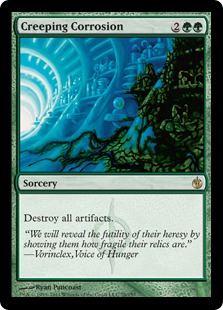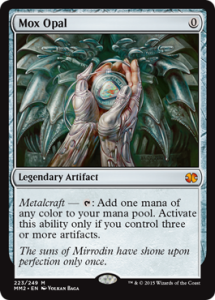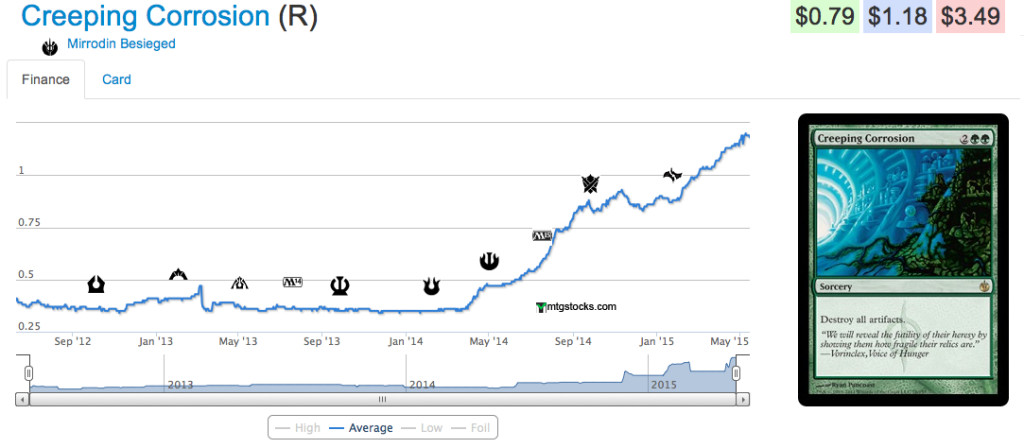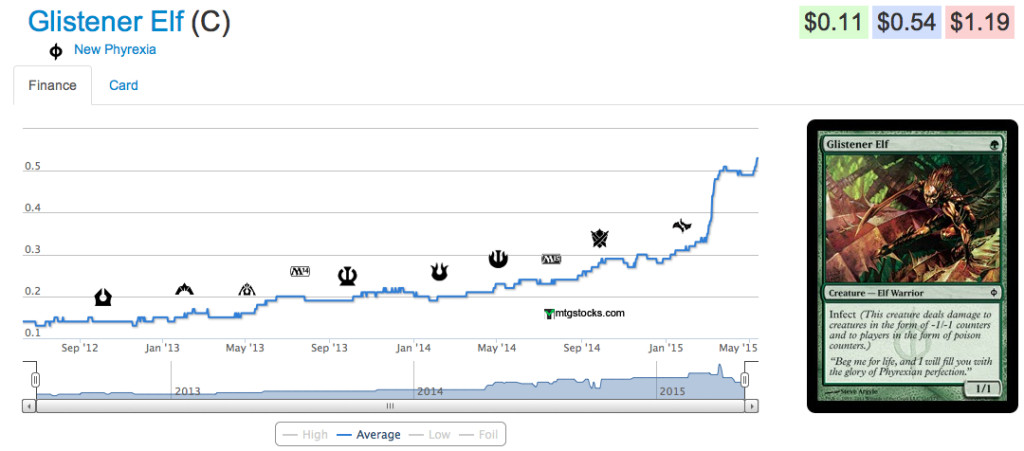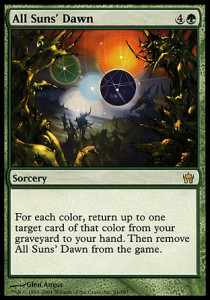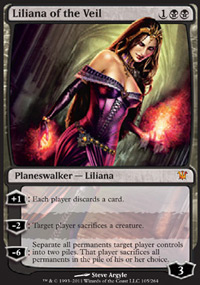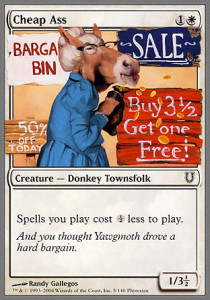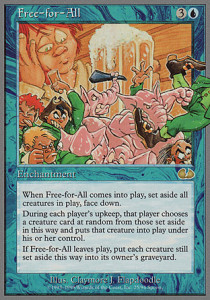Inkmoth Nexus was the first domino to fall.
And, to be honest, it’s not much of a surprise, is it? Mox Opal is reprinted and Inkmoth Nexus is not, that means it should go up, right? Of course. That’s the easy call, and as we know by how quickly this thing disappeared, there’s no money there.
But there is money to made with the knowledge we gained from Modern Masters 2015, and that’s what I’m here to discuss today.
Our experienced staff of writers has done an excellent job breaking down what’s in the set and how they expect the prices on the cards in the set to react over the next few weeks and months. I won’t say much more on this except to expect drops. The whole “But the original Modern Masters increased prices!” line is old at this point, and, more importantly, inaccurate. Yes, a very select few cards rebounded, but the vast majority were either significantly depressed or absolutely crushed of all hope to rebound any time soon (RIP Stonehewer Giant).
The First Wave
As I alluded to above, the first wave is easy to tell. Basically everyone can figure it out, and sometimes those people even go and buy out Inkmoth Nexus. There’s nothing wrong with spotting this low-hanging fruit, of course, and I’d expect nothing less given how savvy the finance community has become over the last few years.
But the way I see it? Let others take this Level One approach. If you’re in early, then great. But if not? Let others chase, and move onto Level Two.
Once the low-hanging fruit is picked, it takes a little more work to find the good targets. And they’re going to, by and large, take a while to pay off. After all, if there was easy short-term money to be made on them, they would be Inkmoth Nexus and already be bought out.
When it comes to finding targets for something like this, the beauty is in how stunningly simple-sounding it is, as well as how much more difficult it is to actually pull off. Everything I’m going to present to you today can be found by anyone willing to put in the work. As the detractors of “MTG finance” like to claim, it’s not like we’re conducting rocket science here. And we’re not. But sometimes finding opportunity does take some legwork, and that’s not something everyone is either able or willing to do. And even if you have put in the work, you also have to know what you’re looking at, and nothing substitutes for experience in that regard. This list is by no means exhaustive considering just how many cards there are that see some amount of play in Modern, but this is wheat I’m working with over the next few months.
Anyway, let’s dig in.
Affinity
The plan today is to look at decks that will see a surge in play thanks to key reprints in Modern Masters 2015, and then evaluate how that could affect the market.
Nothing rests higher in that list than Affinity, and it gives us a ton to work with. Robots are notoriously easy to pick up and difficult to master, and with the only truly outrageous card being Mox Opal, there’s every reason to believe we’re going to see a lot of new players picking this up. After all, Affinity has the ability to win plenty of games out of nowhere, even if you’re still new and not good enough to squeeze every percentage point out of the deck like some of the masters.
So, looking at the deck itself, we see a ton of stuff that’s being reprinted. Mox Opal, Etched Champion, Cranial Plating, Darksteel Citadel and even Thoughtcast are all being reprinted, so basically half an Affinity deck is being handed to players in Draft.
A few key cards are left off, though. Arcbound Ravager is already $20, but I have no doubts this could be $30 in three months. It’s already showing growth and is an auto four-of in any build of the deck. Glimmervoid also likely has some upside at $10.
Looking at a few more niche cards from the deck, Steel Overseer could have a little upside at $7 and Master of Etherium could also see movement. Neither are exactly cheap buy-ins, but I expect them to see incremental growth this year.
Next up is a card that has seen a lot more than incremental growth: Creeping Corrosion. The green Shatterstorm, we’re seeing great movement on this recent bulk rare. You can still get these for basically free at your LGS, and they’re easy to pull out of any random pile of rares. But this has $3-4 written all over it, which is great considering your buy-in is going to be under a dollar.
With Smash to Smithereens reprinted, the next sideboard card that could see some movement is Shattering Spree. A lot less appealing than Creeping Corrosion due to the $5 buy-in, this nonetheless stands to see some gains.
Burn
Nothing huge included in Modern Masters 2015, though we do get Lightning Bolt at uncommon. Goblin Guide is a huge hole, but I’m not sure how much upside there really is considering that Burn has been the best it’s ever been the last few months and already taken cards like Searing Blaze on a ride up.
That said, Goblin Guide has been moving, and is up to $22. This is one of those Level One cards I was talking about, and I’m not sure how much this is chasing at this point. Could it be $30 soon? Sure, but when you’re buying in at $20+ it may be better to park your money in other options.
Molten Rain is an interesting option, and could be a $4-5 common in six months. On the other hand, it could also fall out of favor and languish at $2. Considering its recent stagnation I think it may be too late on this one, though you should certainly keep an eye on for this one laying around.
Infect
Noble Hierarch makes this instantly more available to play, and several other Phyrexian Mana spells being included makes it that much easier to put together. As we already know, Inkmoth Nexus gained big, Spellskite is being reprinted and Might of Old Krosa continues its crazy run from bulk three years ago to $7 today.
Is it worth buying into at that price? While it’s likely to continue climbing for awhile still, I’d rather sink my money into other pieces of the deck.
Two of them in particular, that is: Glistener Elf and Blighted Agent.
If you haven’t seen Glistener Elf as a money card yet, I hope you’re ready to change your mind. It’s well on its way up, and has doubled since 2015 began. Yes, we’re only talking about going from a quarter to 60 cents, but this is exactly where Serum Visions began. Where Gitaxian Probe was a year ago. Where Might of Old Krosa once was.
Glistener Elf will be our next $3-4 common, and Blighted Agent will trail a little behind. The promo version of Glistener Elf is likely the best buy at $3-4 given how very few there are in stock on TCGPlayer, and this could easily be $10 this summer.
The last piece is Wild Defiance, which has already seen astronomical growth. I don’t mind picking these up at $3, though I suspect it won’t go much higher than $5-6.
Elves
This doesn’t benefit so much from Modern Masters 2015 as it does from Collected Company. That said, we’re seeing the little green men popping their heads up all over Modern, even if it’s flown under the radar a little.
We actually saw large parts of this deck reprinted in Commander 2014, which limits the upside on some pieces like Joraga Warcaller (which despite multiple printings probably is still a safe pickup at its current $3).
But there are some pretty good picks here. One is Chord of Calling, which is super cheap since its reprint and is extremely good in these decks. While we’ve sometimes seen Elf decks go the combo route with Cloudstone Curio, the latest builds have been more of the face-smashing type. Craterhoof Behemoth and Regal Force are too expensive at $15 to be super attractive, but Heritage Druid is going to move from $5 to $10 very quickly. Even better could be the near-bulk Nettle Sentinel, which again is more of a volume play than anything else given it’s available at 50 cents a copy and 0 cents a copy in bulk bins everywhere.
…
There are, of course, plenty of other cards in Modern that see play that haven’t been reprinted. Restoration Angel, for instance, sees play across archetypes but hasn’t moved in price for awhile. But I believe giving too much information can be as paralyzing as too little, and naming every card in Modern that might go up isn’t particularly actionable. Instead, I tried to hit upon some of the cards that are impacted by recent events and are on my shortlist of cards to keep an eye out for at my store. Remember, when everyone else is worried about Modern Masters 2015 you want to be the guy worried about what isn’t in the set.
What do you think? Anything along these lines that is also a great target right now?
Thanks for reading,
Corbin Hosler
@Chosler88 on Twitter
